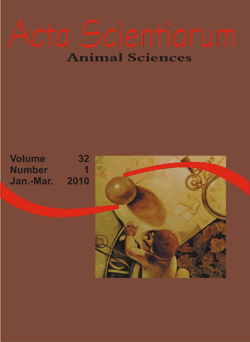<b>Nutrient intake and digestibility and milk yield of cows fed with fermented brewer’s grain</b> - DOI: 10.4025/actascianimsci.v32i1.6990
Keywords:
milk fat, rumen undegradable protein, byproduct of agribusiness
Abstract
The objective this work was to evaluate the inclusion of 0, 5, 10 and 15% of the fermented brewer’s grain (FBG) in diets of dairy cows on intake and total digestibility coefficient (DC) of nutrients, production and milk quality. Twenty-eight Holstein cows were used, with 100 ± 21 days in milk, and average body weight (BW) of 612 ± 110 kg, fed with corn silage, ryegrass silage, FBG and concentrate. Intake data and nutrient’s DC, production and milk quality were subjected to regression analysis to 5% of probability. The DM intake of animals was ad libitum. The FBG inclusion levels in diets did not influence (p > 0.05) nutrient intake. The DC of organic matter (OM), total carbohydrates (TCH), neutral detergent fiber (NDF) and acid detergent fiber (ADF) were not influenced by levels of FBG (p > 0.05); however, the DC of DM, crude protein (CP) and ether extract (EE) increased linearly (p < 0.05) with the levels of inclusion in the diets of the RCF. Inclusion of FBG in diets did not influence (p > 0.05) nutrient intake and production and quality of milk. Thus the FBG can be included until 15% in dairy cow diets without changing nutrient intake and production and quality of milk.Downloads
Download data is not yet available.
Published
2010-04-08
How to Cite
Geron, L. J. V., Zeoula, L. M., Erkel, J. A., Prado, I. N. do, Bublitz, E., & Prado, O. P. P. do. (2010). <b>Nutrient intake and digestibility and milk yield of cows fed with fermented brewer’s grain</b> - DOI: 10.4025/actascianimsci.v32i1.6990. Acta Scientiarum. Animal Sciences, 32(1), 69-76. https://doi.org/10.4025/actascianimsci.v32i1.6990
Issue
Section
Ruminant Nutrition
DECLARATION OF ORIGINALITY AND COPYRIGHTS
- I Declare that current article is original and has not been submitted for publication, in part or in whole, to any other national or international journal.
The copyrights belong exclusively to the authors. Published content is licensed under Creative Commons Attribution 4.0 (CC BY 4.0) guidelines, which allows sharing (copy and distribution of the material in any medium or format) and adaptation (remix, transform, and build upon the material) for any purpose, even commercially, under the terms of attribution.
Read this link for further information on how to use CC BY 4.0 properly.
0.9
2019CiteScore
29th percentile
Powered by 








































